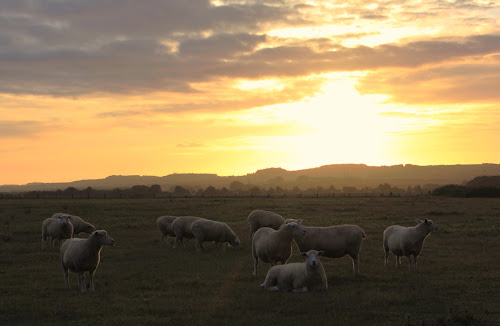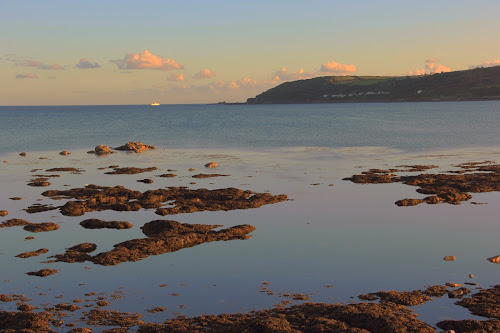"It's our yankee family member!" said Margaret, a Scottish relative who I was meeting for the first time.
After Paris, I took the train back up to London and on to Luton, a small community north of the city, where my father's cousin, Scott Ilgunas, lives with his family.
Scott, an Englishman by birth but a Scotsman at heart, had visited my family in Canada when he was a young man. He'd come to visit us just after having a gun put to his ribs and his wallet stolen in NYC, so he lingered with my family longer than he'd expected so as to give himself time to psychologically adjust to the apparently lawless Western Hemisphere. Eager to return the favor, Scott invited me to spend time with him in Luton, where he'd teach me as much as he knew about the Ilgunas family tree.
His mum Margaret and his brother Gordon stopped by to say hello. They were driving up to Scotland, where they were on a mission to get meat from a Scottish butcher among other matters. Margaret struck me as a strong matriarch, with a head full of sense and a tongue that didn't mince words. She told a grandson: "If you don't have a job by the time I come back, I'm going to kick your arse from here to yonder."
Naturally, I was curious to learn about my family roots. Since both sides of my family are relatively recent immigrants to the U.S., I've had little opportunity to learn about my European roots. My Lithuanian heritage ("Ilgunas" is a Lithuanian name) is a great mystery to me. Why did my great-great-great granddad leave his home country for Scotland? What sort of work did Ilgunas's do? Were they religious? Nature-lovers? Athletes? Bookish? On my mother's side, I'd always considered myself Polish, but I didn't learn until recently that my ancestor's hometown is now within the borders of Ukraine. Scott, though, would help me at least gain an understanding of the Scottish side of the family.
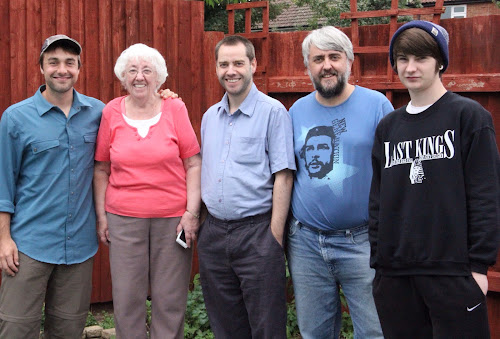
(Apparently British people don't pose with their arms around each other. Ken, Margaret, Gordon, Scott, and Gary.)
Scott tells me that knowledge of our family tree goes back to Jouzas Ilgunas, who married a woman named Elzbeta. Jouzas, my great-great-great grandfather, was Lithuanian-born, and came to Scotland sometime in the 1800's for reasons unknown. (Scott hypothetizes it was due to reasons of war.) Once in Scotland, Jouzas and Elzbeta had a son, who they named "Jouzas," who may have went by "Joseph."
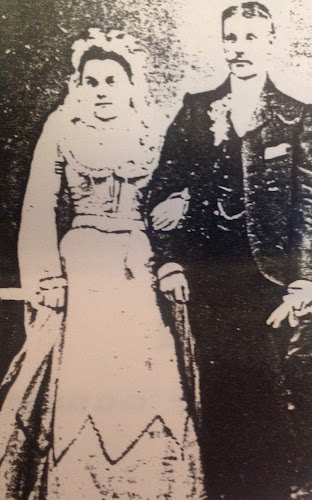
Pictured above are Magdelane Kalwinski (1881-1940) and Scottlish-born Juozas (or Joseph) Ilgunas (1877-1942) at their wedding ceremony. Joseph would be my great-great grandfather. Joseph, to my surprise, according to immigration records, came to New York City when he was 21. Scott hypothesizes that he came to make his fortune, but, perhaps due to ill luck, failed and decided to come back to Scotland. Curiously, on the return voyage to Scotland, Juozas listed his age as 16, possibly to get a cheaper fare. (The cheapskate trait still runs strong in the Ilgunas blood, it seems.) He was a coal miner, and they lived in Holytown, near Motherwell, Scotland.
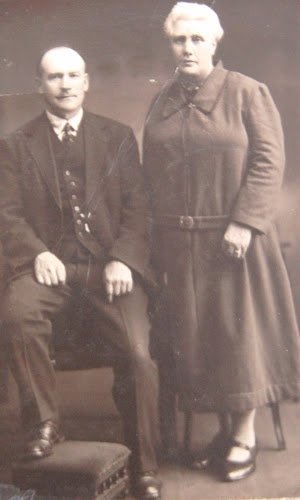
Pictured above are Hugh Holmes Caskie and Annie MacDonald Caskie, parents of great grandma Martha Holmes Caskie Ilgunas. They were from a family of crofters (sheepherders). Annie lived on the Isle of Lewis, born in the town of Stornoway.
Pictured above are great grandpa Joseph Ilgunas (Scottish born 1902-1963) and great grandma Martha Holmes Caskie (1906-1990), who married on June 14, 1924. Joseph was a coal miner. Martha was born on the Isle of Lewis, like her mother Annie. Joseph and Martha's marriage certificate shows that she was a spinster and bakery shop girl. Later, she became a cleaner for a bank, and worked for them for fifty years, into her seventies. "It seems that you need a special kind of woman to become an Ilgunas," said Scott. "Someone who can embrace the 'Ilgunasness.'"
Pictured above are Martha and Joe years later. Martha (1906-1990), Hugh, Great-grandpa Joseph (1902-1963), and Peter Ilgunas (1935-1990)
Picture above are grandma and grandpa Zoladz (born in U.S. of Polish/Ukraine descent); Mother Sistine Ilgunas [nurse] (1950-) and father Ken Ilgunas [factory worker] (1950-); Grandma Rose Anne White Ilgunas [mother of nine] (1925-1974) and Grandpa Joe Ilgunas [ambulence driver] (1925-1987) from Motherwell, Scotland at Mom and Dad's marriage ceremony in New York.
How touching it was to first see the faces of my relatives! In their marriage photos, they were younger than I am today, but when I look upon their youthful faces, I still see them as my elders. They could be pictured as schoolboys, and, if their images could speak, I'd still feel the inclination to call them "grandpa." I delight in observing the physical similarities: the modest height, but proportional build; the high (but not freakishly high!) hairline; the friendly stoicism. I feel a strange draw. They are just pictures, but I want to know them and embrace them as family--a strange sensation, indeed. Is kinship instinctual? Is it our impulse to want to protect, support, and love those with whom we share genes? Or has this idea of "family" been culturally passed down? Perhaps I've unknowingly absorbed our greater culture's tradition to idealize family? Either way, there's an undeniable draw.
Looking at the faces of Juozef, and Joe, and Annie, and Martha, and Margaret, I wonder how my life would have been different if, throughout my adolescence, I'd been surrounded by grandparents, uncles, aunts, nephews, and nieces. Perhaps it would have been more difficult to live an eccentric life with so many influences, so many voices of reason and sense? Perhaps the sheer weight of all that social pressure would have been enough to squash one's individualistic longings?
The next morning, I took the train to the town of Salisbury. I bought a UK cell phone, a UK to US charger adapter, and a new digital watch. There was a tour bus heading to Stonehenge for twenty pounds, and a hostel in town for twenty-five. That being a price too steep for me, I chose to take a city bus to Amesbury for four pounds and walk the rest of the way to Stonehenge (about three miles one way).
I was getting drenched under yet another English rainstorm, and my views were obscured by mist, and fog, and storm cloud, the rain so consistent and heavy I couldn't even think to take my camera out. I made my way across a trail, and then over a sheep and cow pasture, which signs had directed me to cross. From the distance, I saw the stone pillars of Stonehenge, the fallen crown of the Salisbury Plain. And what a sight it was! Though dilapidated and mostly in ruins, the long history of the stones seemed to make them all the more imposing, their age adding a few extra feet in height, the mysteries, a ghostly gleam.
I'd been walking along "the Avenue," where, thousands of years ago, there was a prehistoric road that led all the way to the stones. Now, the Avenue is just a ridge line through cow and sheep pasture. All around me were King Barrows, a series of grassy mounds where important figures had been buried. To my right was where the Stonehenge Cursus was once positioned, a 1.75-mile, elevated race track-like structure, presumably used for ceremonial processions.
(Depiction of "Avenue")
(Depiction of Cursus)
I got to the stones, but was immediately shooed away by a worker, who told me the place had just closed for the night. I went back to the woods and set up my tent next to a King Barrow. When I got into my tent, I was so exhausted that I fell asleep as soon as I encased myself in my sleeping bag, not bothering to zip up the inner bug net section of my tent. I awoke in the middle of the night to discover that hundreds of spiders and plump potato bugs had moved inside with me to escape the rain and steal my body warmth. I felt like a great giant, crushing swarms of creatures with every thoughtless shift of my body. Owls hooted all night long, and, in the morning, I awoke to the gentle footsteps of a small flock of sheep browsing for fresh greens around my tent.
I'd fantasized about jumping the fence and stealing some sunset shots of Stonehenge, but my morning would be occupied with the task of drying out my sodden clothes, as I've learned to savor every bit of sunlight I get in England. Once my clothes had dried, I made my way back across the fields to Stonehenge, where there were hundreds of visitors who'd been brought in by a cavalcade of tour buses, many of whom were college and high school-age girls who'd pose for pictures in front of the stones every ten steps, sometimes pretending the stones were erections thrusting out of their arched abdomens.
I was mesmerized by the stones, but disappointed with England's management of the area. For one, the A303 highway runs alongside the stones (maybe about 400 yards away), so the buzz of heavy traffic is always within earshot, which I deem a crime of the highest order and an unbelievable desecration of our human heritage. (To their credit, they just closed the A344, which was, bafflingly, just a few feet from the stones.) Also, there's a mammoth parking lot not far off, which, in addition to the road, are the two unforgivable manmade features that corrupt an otherwise serene vista.
For thousands of years, the men and women and children who visited Stonehenge had to walk to get there. Why not move the parking lot a few miles away, rebuild the Avenue and Cursus using primitive tools, and require that visitors follow that ancient path, which will make the area more beautiful, the occassion more solemn, and the visit less a tourist destination and more a pilgrimage? Perhaps a good walk will give visitors time to contemplate the incredible task of moving the stones up this path, and consider the countless pilgrims who'd come here before to scatter ashes, bury their dead, pray to the gods, or simply meet up with long lost friends and family members--and maybe the journey will put us in a frame of mind to do something other than pretend the stones are gargantuan erections.
It is engrossing to think about this place. It's construction began some 5,000 years ago, and had been re-imagined and enhanced for thousands of years thereafter. Many of the stones are from Wales, and there are others from the relatively nearby Marlborough Downs, 25 miles from Stonehenge. The stones themselves are more complex than rectangular slabs. They'd been sculpted into their rectangular shape, and designed with mortise and tenon joints to strengthen the structure. The remains of mainland Europeans have been discovered, as has livestock from the Highlands, suggesting that Stonehenge was known far and wide. The stones, themselves, are positioned to be geometrically and astronomically precise, with the sun rising over certain stones at the summer and winter solstice.
I suppose I'm just impressed that they put so much effort into something so unnecessary. They could have used their spare time to loaf or engage in pointless tribal wars, but, instead, they chose to build something that would dazzle mankind for millenia. How did they "buy" the stones from Wales? Was there a trade, a payment, or was it a society's labor of love? Were the laborers slaves, or compensated in some way? Is Stonehenge a community's creation, or a few monomaniacs' wild visions?
Life must have been fairly comfortable to be able to devote so much time and resources to an inessential project. I would have thought that people at such a far-flung place 4,000 years ago would still be living a pretty hand-to-mouth existence, but clearly they must have been well-provisioned with food to sustain a labor force of builders, movers, and sculptors. Add in their impressive logistics, transport, surveying, and astronomical knowledge, and those who built it were part of a truly impressive culture, indeed. It likely would have been an event of a lifetime for a highlander to set his eyes on the stones, yet today, it's no more than a photo op and an afternoon diversion. Currently, plans are in the works to move the parking lot and build a visitor center, but English Heritage reports that there will be a "transit system" from there to the stones. It's the ulimate irony that all we have to do is pay a fee and sit on our kesiter to view one of the most incredible feats of human strength and ingenuity.
In the early afternoon, I walked back to the bus station, then got on a train for Penzance, on the Cornish coast in Southwestern England, before taking off north to the Lake District, then Scotland.
(Camping spot with King Barrow nearby.)
(Sunset view from tent.)
(Sheep pasture near Stonehenge.)
(Trail to Stonehenge.)
(The Nile Clumps on the walk to Stonehenge. These trees -- many of which are beech -- commemorate the Battle of the Nile, when Admiral Nelson, in the early 1800's, dominated a French fleet. At one point, there were 26 ships represented, but now there are seventeen.)
(While taking this picture, a lady, ambling by, exclaimed, "Penzance is just delicious!")
(Sleeping on the beach. In the dark, several people walked past me. One guy was singing "You've Lost that Loving Feeling." A young many sobbed on the phone, exclaiming, "How did that happen!? She just left me!" Another couple giggled, holding hands.)
















